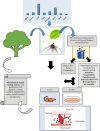A critical overview of challenging roles of medicinal plants in improvement of wound healing technology
- PMID: 38225520
- PMCID: PMC11087437
- DOI: 10.1007/s40199-023-00502-x
A critical overview of challenging roles of medicinal plants in improvement of wound healing technology
Abstract
Purpose: Chronic diseases often hinder the natural healing process, making wound infections a prevalent clinical concern. In severe cases, complications can arise, potentially leading to fatal outcomes. While allopathic treatments offer numerous options for wound repair and management, the enduring popularity of herbal medications may be attributed to their perceived minimal side effects. Hence, this review aims to investigate the potential of herbal remedies in efficiently treating wounds, presenting a promising alternative for consideration.
Methods: A literature search was done including research, reviews, systematic literature review, meta-analysis, and clinical trials considered. Search engines such as Pubmed, Google Scholar, and Scopus were used while retrieving data. Keywords like Wound healing 'Wound healing and herbal combinations', 'Herbal wound dressing', Nanotechnology and Wound dressing were used.
Result: This review provides valuable insights into the role of natural products and technology-based formulations in the treatment of wound infections. It evaluates the use of herbal remedies as an effective approach. Various active principles from herbs, categorized as flavonoids, glycosides, saponins, and phenolic compounds, have shown effectiveness in promoting wound closure. A multitude of herbal remedies have demonstrated significant efficacy in wound management, offering an additional avenue for care. The review encompasses a total of 72 studies, involving 127 distinct herbs (excluding any common herbs shared between studies), primarily belonging to the families Asteraceae, Fabaceae, and Apiaceae. In research, rat models were predominantly utilized to assess wound healing activities. Furthermore, advancements in herbal-based formulations using nanotechnology-based wound dressing materials, such as nanofibers, nanoemulsions, nanofiber mats, polymeric fibers, and hydrogel-based microneedles, are underway. These innovations aim to enhance targeted drug delivery and expedite recovery. Several clinical-based experimental studies have already been documented, evaluating the efficacy of various natural products for wound care and management. This signifies a promising direction in the field of wound treatment.
Conclusion: In recent years, scientists have increasingly utilized evidence-based medicine and advanced scientific techniques to validate the efficacy of herbal medicines and delve into the underlying mechanisms of their actions. However, there remains a critical need for further research to thoroughly understand how isolated chemicals extracted from herbs contribute to the healing process of intricate wounds, which may have life-threatening consequences. This ongoing research endeavor holds great promise in not only advancing our understanding but also in the development of innovative formulations that expedite the recovery process.
Keywords: Clinical trial; Herbs; Nanotechnology; Wound dressing; Wound healing.
© 2024. The Author(s), under exclusive licence to Tehran University of Medical Sciences.
Conflict of interest statement
The authors declare no conflict of interest.
Figures








Similar articles
-
Dressings and topical agents for treating venous leg ulcers.Cochrane Database Syst Rev. 2018 Jun 15;6(6):CD012583. doi: 10.1002/14651858.CD012583.pub2. Cochrane Database Syst Rev. 2018. PMID: 29906322 Free PMC article.
-
Herbal and dietary therapies for primary and secondary dysmenorrhoea.Cochrane Database Syst Rev. 2001;(3):CD002124. doi: 10.1002/14651858.CD002124. Cochrane Database Syst Rev. 2001. Update in: Cochrane Database Syst Rev. 2016 Mar 22;3:CD002124. doi: 10.1002/14651858.CD002124.pub2. PMID: 11687013 Updated.
-
Dressings and topical agents for treating pressure ulcers.Cochrane Database Syst Rev. 2017 Jun 22;6(6):CD011947. doi: 10.1002/14651858.CD011947.pub2. Cochrane Database Syst Rev. 2017. PMID: 28639707 Free PMC article.
-
Hydrogel dressings for venous leg ulcers.Cochrane Database Syst Rev. 2022 Aug 5;8(8):CD010738. doi: 10.1002/14651858.CD010738.pub2. Cochrane Database Syst Rev. 2022. PMID: 35930364 Free PMC article.
-
Dressings and topical agents for the management of open wounds after surgical treatment for sacrococcygeal pilonidal sinus.Cochrane Database Syst Rev. 2022 May 20;5(5):CD013439. doi: 10.1002/14651858.CD013439.pub2. Cochrane Database Syst Rev. 2022. PMID: 35593897 Free PMC article.
Cited by
-
Polymer Gels Based on PAMAM Dendrimers Functionalized with Caffeic Acid for Wound-Healing Applications.Gels. 2025 Jan 4;11(1):36. doi: 10.3390/gels11010036. Gels. 2025. PMID: 39852007 Free PMC article.
-
Biological Effects of Rosaceae Species in Skin Disorders-An Up-To-Date Overview.Plants (Basel). 2025 May 24;14(11):1605. doi: 10.3390/plants14111605. Plants (Basel). 2025. PMID: 40508280 Free PMC article. Review.
-
Phytochemical Analysis and Therapeutic Potential of Tuberaria lignosa (Sweet) Samp. Aqueous Extract in Skin Injuries.Plants (Basel). 2025 Jul 25;14(15):2299. doi: 10.3390/plants14152299. Plants (Basel). 2025. PMID: 40805647 Free PMC article.
-
Natural products in the treatment of diabetic foot infection.Eur J Med Res. 2025 Jan 7;30(1):8. doi: 10.1186/s40001-024-02255-y. Eur J Med Res. 2025. PMID: 39773682 Free PMC article. Review.
-
Pectin/Gellan Gum Hydrogels Loaded with Crocus sativus Tepal Extract for In Situ Modulation of Pro-Inflammatory Pathways Affecting Wound Healing.Polymers (Basel). 2025 Mar 20;17(6):814. doi: 10.3390/polym17060814. Polymers (Basel). 2025. PMID: 40292702 Free PMC article.
References
Publication types
MeSH terms
Substances
LinkOut - more resources
Full Text Sources

